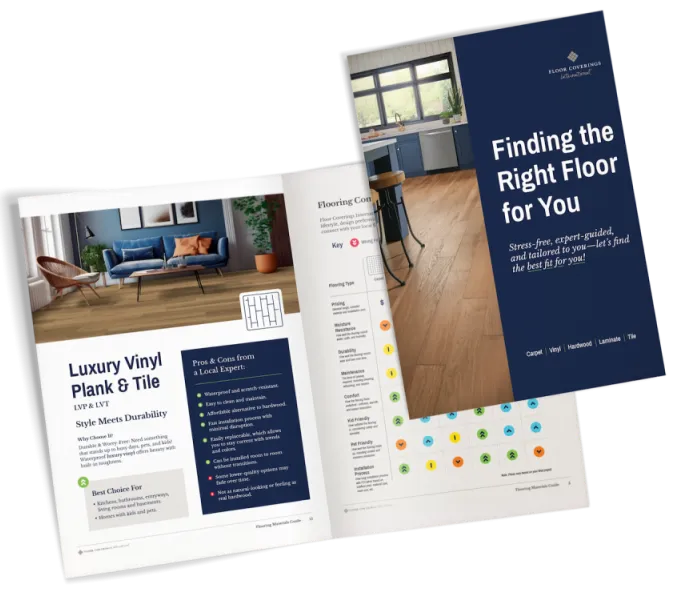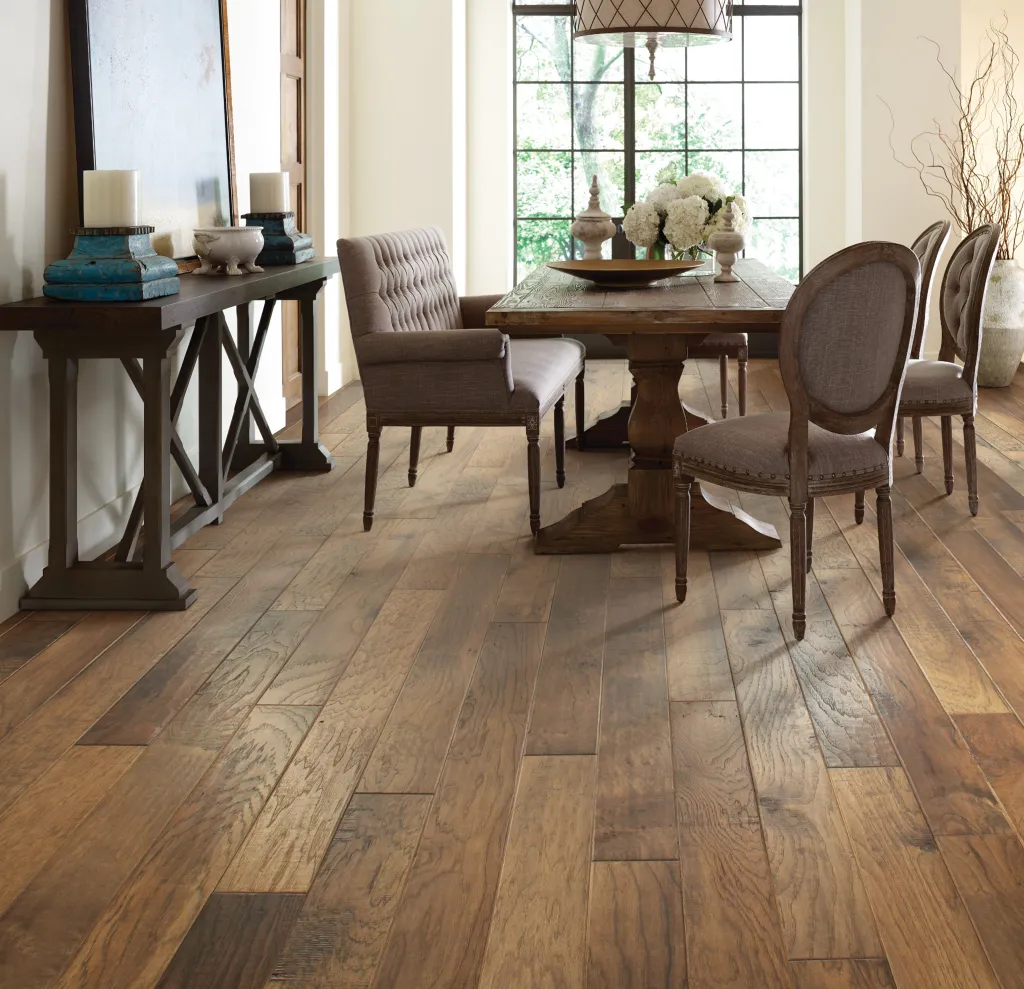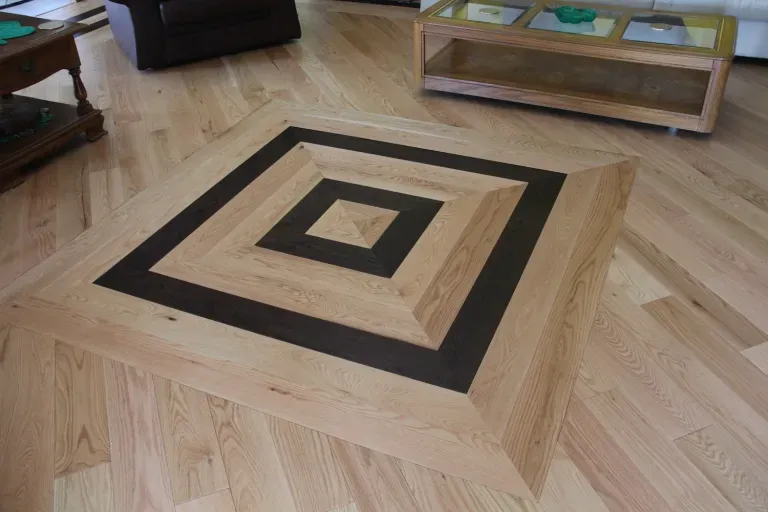Nothing beats the natural appearance of real wood floors. Both engineered and hardwood flooring are natural, high-quality products that appear almost identical to the uninitiated eye. If you’re looking to bring the beauty of wood floors home or update your existing wood floors, you’ll need to understand the advantages and disadvantages of both types of wood flooring. That’s where Floor Coverings International® can help. Go beneath the planks to learn the difference between hardwood and engineered flooring.
Engineered Wood Flooring vs. Hardwood Flooring
On the surface, both flooring types offer the natural look and feel of natural hardwoods like oak, maple, or walnut. However, the similarities end there; engineered wood is topped by a thin layer of real wood and bonded to plywood or a high-density fiberboard (HDF). Solid wood floors use the same natural hardwood for the entirety of the plank, with no bonded veneer. This results in vastly different expectations for maintenance, longevity, and other considerations.
Engineered Hardwood vs. Solid Wood: Appearance
Engineered wood flooring is available in a range of colors and tree species, including hickory, maple, walnut, cherry, and pine. Planks are usually wider than real wood and tend to have beveled edges to make fitting boards a little easier.
Solid hardwood flooring is available in a wider range of species and colors. It’s also available in prefinished and unfinished boards.
Prefinished boards are stained, beveled, and sealed with several layers of polyurethane. These boards are faster and easier to install with minimal interruption, making it the easy choice for busy homes and businesses.
On-site finished boards, or unfinished boards, are installed as raw wood. Sanding and staining occur at the place of installation, which allows for a degree of customization in terms of stain matching and edge detail. The process takes longer, but it delivers excellent results for new builds, home restorations, and homeowners seeking a tailored appearance.
Real Hardwood Floors vs. Engineered Wood: Durability
Engineered wood flooring features a real hardwood surface layer, and its durability depends largely on the thickness of that top veneer. Higher-quality engineered products (with a 3mm or thicker veneer) can be sanded and refinished just like solid hardwood—while thinner veneers may only allow for light buffing or a single refinish. Minor scratches can often be sanded out, but deeper damage that reaches the core layer is harder to repair. With proper care, engineered wood floors can last 20 to 30 years or more. They’re also more dimensionally stable than solid wood, making them better suited for rooms with some humidity fluctuation.
Solid hardwood floors, on the other hand, are made entirely of natural wood and can be sanded and refinished multiple times over their lifespan. Small surface scratches are easy to remove, and homeowners don’t have to worry about wearing through a surface layer. A well-maintained hardwood floor will last longer than an engineered wood floor, up to 50 years or more!
Engineered Wood vs. Hardwood Floors: Cost and Installation
Engineered wood material is usually much easier to install and is generally sold in a click-lock style. It also tends to be less expensive than most hardwood options, starting around $4 per square foot, though premium options may run as high as $15 per square foot.
Hardwood flooring is usually cut to a tongue-and-groove system, with each plank nailed to the subfloor through the tongue. To ensure years of worry-free use, it’s best to let your local Floor Coverings International® team install your new wood floor.
Advantages and Disadvantages of Hardwood Flooring and Engineered Wood
See how these two popular flooring materials stack up head-to-head:
| Disadvantages of Engineered Wood Flooring – Refinishing is not possible for all engineered hardwoods – Still not waterproof – Quality varies widely by manufacturer – May emit volatile organic compounds (VOCs) from glue |
Advantages of Engineered Wood Flooring – Less expensive – More resistant to moisture & temperature changes – Offered in wider widths than solid hardwoods – An eco-friendly option |
| Disadvantages of Hardwood Flooring – Susceptible to water damage – More expensive – Prone to scratches in high-traffic areas – May warp with changing temperatures and humidity |
Disadvantages of Engineered Wood Flooring – Refinishing is not possible for all engineered hardwoods – Still not water proof – Quality varies widely by manufacturer – May emit volatile organic compounds (VOCs) from glue |
Is Engineered Hardwood Waterproof?
Engineered wood is not waterproof, though it is more water-resilient than solid hardwood flooring when exposed to humidity or light spills. The HDF or plywood base in engineered wood is less susceptible to warping than hardwood planks. Still, engineered wood materials aren’t a good fit for high-humidity areas of the home, like bathrooms.
How Do You Care for Engineered Floors?
Taking care of engineered wood floors is very similar to maintaining hardwood floors because the surface layer is made of natural wood. While manufacturer instructions may vary slightly, we recommend sweeping or vacuuming daily or as often as possible. Damp mops are okay for engineered wood materials, but never use wet mops on either type of flooring. Avoid cleaning products with harsh chemicals like ammonia or bleach, and dry with a dry mop or by hand after using a damp mop.
Hardwood or Engineered Flooring: Which Is Better?
Most homeowners prefer hardwood flooring for its timeless appeal, strong resale value, and durability. Of course, that doesn’t mean engineered wood floors aren’t the right choice for your home. When you speak with a Design Associate, we’ll help you prioritize the features that matter most and find the right flooring to suit your taste, budget, and applications.
Take the guesswork out of choosing flooring material with the friendly professionals at Floor Coverings International®; find a location near you or schedule an appointment today!
Choosing the Right Floors for Your Home
Download our free Flooring Guide to learn more!



